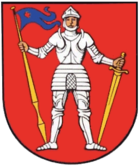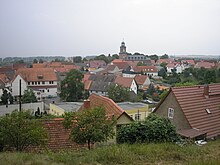Rastenberg
| coat of arms | Germany map | |
|---|---|---|

|
Coordinates: 51 ° 11 ′ N , 11 ° 25 ′ E |
|
| Basic data | ||
| State : | Thuringia | |
| County : | Sömmerda | |
| Management Community : | Koelleda | |
| Height : | 205 m above sea level NHN | |
| Area : | 35.52 km 2 | |
| Residents: | 2482 (December 31, 2019) | |
| Population density : | 70 inhabitants per km 2 | |
| Postal code : | 99636 | |
| Primaries : | 036377, 036378 | |
| License plate : | SÖM | |
| Community key : | 16 0 68 042 | |
| LOCODE : | DE RSR | |
| City structure: | 6 districts | |
City administration address : |
Markt 1 99636 Rastenberg |
|
| Website : | ||
| Mayor : | Beatrix Winter (community of voters "Together for Rastenberg") | |
| Location of the town of Rastenberg in the Sömmerda district | ||
Rastenberg is a town in the Sömmerda district in Thuringia . She belongs to the administrative community Kölleda .
geography
The city is located on the southwestern slope of the Finn with the transition to the arable farming area of the Thuringian Basin . The state road 1057 connects Rastenberg with the surrounding area. Coming from the north, the river Lossa flows in an arch through the eastern old town, to the south the Rollbach flows.
City structure
In addition to the core city, the city consists of the districts Bachra , Roldisleben , Rothenberga and Schafau . The Finneck settlement also belongs to the core city . The settlement is located in the north of Rastenberg on the outskirts and can be reached via the 2157 road to Rothenberga. The Finneck settlement consists of several houses and is used by a foundation for disabled people.
history
The city was first mentioned in 1070. It was probably during this time that the Raspenburg (1070 to 1078) was built by the Ludowingers . There are contradicting information about the builders of the castle. It can be assumed that they were the sons of Ludwig the Bearded , Ludwig the Springer or his brother Heinrich Raspe. The castle was located near the Via Regia , the trade route Erfurt - Naumburg (Saale) , and around 1313 had the reputation of a robber baron's castle. It was therefore destroyed in 1321 by Friedrich the bitten with the help of the Mühlhausen and Erfurt merchants. In the heyday of the castle there was also a nunnery, but it was closed during the Reformation . The extinct, knightly Burgmann family of Rastenberg named after the place is documented from 1252.
The castle ruins and the associated land were received by the Counts of Orlamünde as a Wettin fiefdom and partially renewed. In 1378 the village of Rastenberg was elevated to a town by the Wettins . On October 28, 1464 Rastenberg got from the sons of the Saxon Elector Frederick the meek , Ernst and Albrecht , the city charter again explicitly confirmed. When the country was divided in 1485 ( Leipzig division ) and 1572 ( Ernestine division ), Rastenberg became part of the Ernestine and Weimar lines. In the 17th century, Rastenberg belonged to that part of the Brembach Bailiwick that remained with the Duchy of Saxony-Weimar when it was divided in 1662 and was affiliated to the Hardisleben office in 1735 . In 1741 the place came with this to the Duchy of Saxony-Weimar-Eisenach . The locations of the Hardisleben office belonged to the Buttstädt office since 1817 , which was opened in the Apolda administrative district of the Grand Duchy of Saxony-Weimar-Eisenach in 1850 .
At the end of the Thirty Years' War , Rastenberg had 150 households and 545 inhabitants - this was the result of a visit on July 12, 1650. The two iron-rich mineral springs discovered in 1646 aroused the hope of the mayor at that time, Hickethier , of being able to open a spa in the city as early as 1648 these first mineral springs dried up again - probably as a result of construction work. With newly drilled springs, the city found a certain income from bathing until 1822 . Between 1907 and 1924, potash salts were mined in the nearby potash shafts at Billroda, Lossa and Bernsdorf. The Weimar-Rastenberger Eisenbahn-Gesellschaft (WREG) was founded on March 29, 1886. The Weimar-Rastenberg narrow-gauge railway was operated from June 26, 1887 to April 11, 1946. A train station with a locomotive shed was built in Rastenberg.
Because they were distributing leaflets, the chairman of the Communist Party of Germany, Willibald Pasche (1905–1943), as well as Frieda Kathe, Otto Kohlmann, Wilhelm Spangeberg and Frieda Respondek were briefly taken into "protective custody" in 1933. In 1934 Pasche was arrested when a money was handed over that he collected for illegal purposes and sentenced to one year and six months in prison for "preparing for high treason". The "unworthy of defense" until then was drafted into the penalty battalion 999 in 1943 and died in Italy in 1943.
During the Second World War , 280 prisoners of war from France , housed in a barred room in the lower gate of the manor, as well as women and men from Poland , the Soviet Union , Serbia and Belgium had to do forced labor : in the Rothenberga manor , in the malt house and at other municipal companies and craftsmen from Rastenberg, on the Stadtgut and in the state forest Revier Hardisleben .
Population development
Development of the population (from 1994 December 31st) :
|
|
|
|
|
Culture and sights
The ruins of the Raspenburg are in Rastenberg .
The Rastenberg forest swimming pool was inaugurated in 1925. It has a water surface of 5000 m² and is located in an idyllic location in the middle of the high forest and is a listed building. In the changing rooms of the swimming pool, which have been converted into a museum, the history of the pool is clearly presented.
The old town of Rastenberg also has some attractions to offer. Among many old buildings, such as the Raspehaus in the eastern old town, the medieval-style town hall, which was built in 1565, stands out. It is one of the most beautiful town halls in Thuringia and, with the artistic wall paintings inside, it also has a lot to tell about the town's history.
The old town is surrounded by the city wall, which was renewed in 1711 and which, with its two defense towers, is in an astonishingly good condition.
Nature lovers and hikers will also get their money's worth in the forest surrounding the city with numerous well-tended hiking trails. The Burgberg, Fuchsturm and Kapellenberg offer a breathtaking view of the landscape of the Thuringian Basin
The local history museum in the city center explains the living conditions around 1900.
Once a year the traditional cherry festival invites you to celebrate and dawdle.
Town twinning
- Leun in Hesse
- Rastenfeld in Austria
Economy and Infrastructure
Schools and educational institutions
- State primary school in Rastenberg
- Staatliche Regelschule Rastenberg (was closed in 2004. The regular school operation is now run by the RS Prof. Gräfe Buttstädt .)
- Rastenberg City Library
- Finneck Community School "Maria Martha"
tourism
Tourist attractions are the historic-style forest swimming pool and the large campsite with an original camping cinema above the pool, as well as the numerous varied hiking trails through the forests in the vicinity of Rastenberg. The spa operation that made Rastenberg famous in the 19th century was discontinued until further notice when the spa building was demolished in 2005.
Personalities
- Gerhard Hoffmann (1690 – around 1756), composer and wind player
- Johann Samuel Schröter (1735–1808), theologian, fossil collector and paleontologist
- Rudolf Gross (1888–1955), politician, member of the Reichstag (NSDAP)
- Hellmuth Vetter (1910–1949), physician who carried out human experiments in various Nazi concentration camps
- Heinz Volpert (1932–1986), Colonel in the Ministry of State Security
literature
- Andreas Vogel: Rastenberg. History in pictures. Geiger-Verlag, Horb am Neckar 1994, ISBN 3-89264-919-7 .
- Hans Moes: Eckartsberga, Rastenberg, Bad Sulza. VEB Bibliographical Institute, Leipzig 1961.
- Markus Vette (Red.): Rastenberg in 2014. 50 years of the new age cherry festival. “From Kiliansfest to Kirschfest” (= series of publications by the Rastenberg Heimatverein. 9). Eugenia-Verlag Vette, Rastenberg 2014, ISBN 978-3-938853-28-3 .
Individual evidence
- ^ Population of the municipalities from the Thuringian State Office for Statistics ( help on this ).
- ↑ City districts of Rastenberg on the city's website ( memento of the original from March 12, 2012 in the Internet Archive ) Info: The archive link was automatically inserted and not yet checked. Please check the original and archive link according to the instructions and then remove this notice. Retrieved March 6, 2012.
- ↑ Finneck Foundation.Retrieved February 23, 2018.
- ↑ wahlen.thueringen.de
- ↑ wahlen.thueringen.de
- ^ The locations of the Brembach Bailiwick in the history of the city of Buttelstedt
- ^ Frank Boblenz : Rastenberger Gesundbrunnen in the 17th century (part 1). In: Sömmerdaer Heimatheft. 8, 1996, ZDB -ID 1158652-7 , pp. 74-77.
- ↑ Thuringian Association of the Persecuted of the Nazi Regime - Association of Antifascists and Study Group of German Resistance 1933–1945 (Ed.): Local history guide to sites of resistance and persecution 1933–1945. Volume 8: Thuringia. VAS - Verlag für Akademische Schriften, Frankfurt am Main 2003, ISBN 3-88864-343-0 , p. 273.
- ↑ Bärbel Aschenbrenner: Camping Cinema Rastenberg. Retrieved April 23, 2017 .
Web links
- Railway lines near Rastenberg and potash pits ( memento from December 18, 2014 in the Internet Archive )








